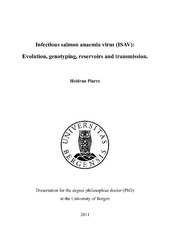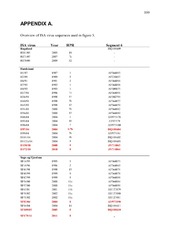| dc.contributor.author | Plarre, Heidrun | eng |
| dc.date.accessioned | 2012-08-20T09:28:51Z | |
| dc.date.available | 2012-08-20T09:28:51Z | |
| dc.date.issued | 2012-06-01 | eng |
| dc.identifier.isbn | 978-82-308-2042-1 | en_US |
| dc.identifier.uri | http://hdl.handle.net/1956/5958 | |
| dc.description.abstract | The first officially registered outbreak of infectious salmon anaemia (ISA) started in Norway in November 1984 (Thorud and Djupvik, 1988). It was a chronically proceeding disease among Atlantic salmon (Salmo salar) parr in a hatchery on the West Coast of Norway (Bremnes). Affected salmon were lethargic with pale gills, fin rot, exophthalmia, and haemorrhages in the anterior eye chamber and abdominal skin. Other clinical signs were a dark, pale or yellowish liver, a dark and swollen spleen, congested intestinal walls, petechia in periviceral fat, ascitic fluid, oedemas, haemorrhages in the swim bladder wall, and muscular haemorrhages. About 80% of the parr in the hatchery died during that winter and spring. Judging from the pathological findings, "Hitra disease" was suspected, however, no bacteria were isolated from diseased fish and oxytetracycline did not reduce mortality. In the following years a disease with similar clinical and pathological signs occurred in smolt and adult salmon in marine farms that had received smolt form this hatchery (Thorud 1991). The first official registration of ISA came at a very bad time for Norwegian salmon production. One problem was an ongoing discussion of the causes of "Hitra disease". Some insisted it was caused by malnutrition (Poppe et al 1986; Salte et al 1987), while others believed it was a bacterial disease (Holm et al 1985; Egidius et al 1986; Totland et al. 1988) and even managed to culture the bacterium that was later named Vibrio salmonicida (disease: cold water vibriosis). The dispute about the causes of "Hitra disease" goes back to the end of the seventies, and later studies have indicated that the reason for the disagreement was probably that "Hitra disease" encompassed at least three different diseases: cold water vibriosis, cardiomyopathy and ISA. There are several indications of this in articles published in Norwegian (cf. Frisk Fisk brochure from this period, i.e. published reports from the Norwegian Research council). In some electron microscopic studies of tissues from salmon with "Hitra disease", the authors were not able to detect any bacteria and described pathological changes that later studies have shown to be associated with ISA. Even as late as in 1987 the three diseases were confused. One farm in Northern Norway was given the diagnosis Bremnes syndrome (i.e. ISA), but this was later changed to cardiomyopathy. The reason for the confusion was of course the lack of a safe diagnosis. The first indication of ISA can probably be found as early as in 1977 (cf: Poppe et al. 1983). The authors give a review of haemorrhagic syndrome of Atlantic salmon in Norwegian aquaculture. The first case of haemorrhagic syndrome was registered in September/October 1977 in a fish farm close to Hammerfest, Northern Norway. They were not able to isolate any infective agent and therapy with oxytetracycline did not influence the mortality. The same disease was also registered in 1978 and in 1979 it was found in other areas in Northern Norway. Several explanations were given for this syndrome: stress, environmental stress, genetics, water temperature, malnutrition, virus (VHS, but it was not possible to isolate this virus), bacteria (it was not always possible to isolate bacteria, but in some farms Vibrio spp. were found), and physical factors. Studies of tissues from fish with haemorrhagic syndrome have later revealed the presence of ISA virus particles in some of these tissues (A. Nylund, pers. com.). ISA was first named "Bremnes syndrome" after the locality of the first official appearance. This was later changed to Salmon anaemia syndrome (SAS). However, protest from an airline company made another change of name necessary and in 1990 ISA (Infectious Salmon Anaemia) was recognised by the Office International des Epizooties. In the period from the first official outbreak in 1984 until 1991 there was a steady increase in the number of outbreaks of the disease with around 80 in 1990 and 1991 (Figure 1). This increase lead to changes in the structure of salmon farming in Norway. The farmers introduced a system with separate generations at each site and the Norwegian Food Authorities introduced a number of regulatory actions like introduction of zones to combat outbreaks. This lead to a new situation in 1994 with only one official outbreak of ISA (cf. Håstein et al 1999). The number of outbreaks since 1994 up to the present has increased again to around 10 - 15 outbreaks every year. The number of outbreaks does not reflect the increase in the amount of salmon produced in the same period (1994 - 2010), indicating a certain degree of stabilisation. | en_US |
| dc.language.iso | eng | eng |
| dc.publisher | The University of Bergen | en_US |
| dc.relation.haspart | Paper I: Plarre H, Devold M, Snow M, Nylund A (2005). Prevalence of infectious salmon anaemia virus (ISAV) in wild salmonids in western Norway. Diseases of Aquatic Organisms 66(1): 71 – 79, August 2005. The article is available at: <a href="http://hdl.handle.net/1956/5957" target="blank">http://hdl.handle.net/1956/5957</a> | en_US |
| dc.relation.haspart | Paper II: Nylund A, Plarre H, Karlsen M, Fridell F, Ottem KF, Bratland A, Sæther PA (2007). Transmission of infectious salmon anaemia virus (ISAV) in farmed populations of Atlantic salmon (Salmo salar). Archives of Virology 152(1): 151-179, August 2007. Full text not available in BORA due to publisher restrictions. The article is available at: <a href="http://dx.doi.org/10.1007/s00705-006-0825-9" target="blank"> http://dx.doi.org/10.1007/s00705-006-0825-9</a> | en_US |
| dc.relation.haspart | Paper III: Plarre H, Nylund A, Karlsen M, Brevik Ø, Sæther PA, Vike S. Evolution of ISA virus (ISAV). Full text not available in BORA. | en_US |
| dc.title | Infectious salmon anaemia virus (ISAV): Evolution, genotyping, reservoirs and transmission | en_US |
| dc.type | Doctoral thesis | |
| dc.rights.holder | Copyright the author. All rights reserved | en_US |
| dc.subject.nsi | VDP::Agriculture and fishery disciplines: 900::Fisheries science: 920 | en_US |
| dc.subject.nsi | VDP::Mathematics and natural science: 400::Basic biosciences: 470 | en_US |

